To keep things ticking over while I’m in Auckland for the Royal Society’s inaugural Science Book Prize presentation here are a few items that have caught my eye over the last few days:
- The BBC reports on the end of the Catlin Arctic Ice Survey expedition, and prompts UK ice specialist Peter Wadhams to comment on the current state of the ice: “By 2013, we will see a much smaller area in summertime than now; and certainly by about 2020, I can imagine that only one area will remain in summer.” For this year, the Canadian Ice Service expects a summer minimum similar to the last two years.
- However much I moan about NZ’s big emitters arguing for delay and inaction (there was a particularly specious piece by Catherine Beard of the Greenhouse Policy Coalition in the Herald yesterday), our politicians have it easy compared to lawmakers in Washington. The Guardian reports that coal and oil interests lobbying against emissions reductions have spent US$45 million in the first three months of this year.
- Aficionados of conspiracy theories (Wishart, are you reading this?) will enjoy this review by Johann Hari of Voodoo Histories, a new book by David Aaronovitch: “[Aaronovitch] argues that we keep returning so obsessively to conspiracy theories because they are, paradoxically, reassuring. “Paranoiaâ€, he writes, “is actually the sticking plaster we fix to an altogether more painful woundâ€: the knowledge that life is chaotic and random and nobody is in charge.”
- New Scientist explores the deep roots of our understanding of the greenhouse effect by looking at the life of John Tyndall. Well worth a read.

 Another day,
Another day, 

 “It’s a strange, evil, gorgeous, horrible, fantastic place,” calls out photojournalist
“It’s a strange, evil, gorgeous, horrible, fantastic place,” calls out photojournalist  As winter turns to spring and the melt season begins, the Arctic sea ice looks to be primed for another bad summer. Multi-year ice is down to only 10% of the total extent — down from 40% during 1979-2000, and new work on ice thickness suggests that the ice cover is thinner than at any point in the recent past. At a NASA/NSIDC
As winter turns to spring and the melt season begins, the Arctic sea ice looks to be primed for another bad summer. Multi-year ice is down to only 10% of the total extent — down from 40% during 1979-2000, and new work on ice thickness suggests that the ice cover is thinner than at any point in the recent past. At a NASA/NSIDC